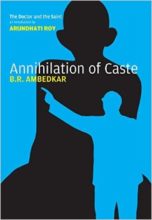Robert Wood reviews Annihilation of Caste by Ambedkar, introduced by Arundhati Roi
 Annihilation of Caste
Annihilation of Caste
B.R. Ambedkar
ISBN 9781742588018
Reviewed by ROBERT WOOD
When I was living in Chembur (Bombay) in 2016, there was a statue of a portly and bespectacled B. R. Ambedkar at the end of my street. This suggests he has been lionised in India, if not quite canonised, something aided in ‘the West’ by Arundhati Roy’s well-publicised talk ‘The Doctor and the Saint’ that favourably compares Ambedkar to Gandhi. And so, it was with the contour of knowledge that I opened Annihilation of Caste. I do, of course, come from an Indian family and have parents who were born as colonial subjects in occupied Kerala. But our path to liberation was different from the national story, inflected by a regional identity, a Communist atmosphere and a Catholic bent. So what was I to make of the lessons in Annihilation of Caste and what can we learn from them to make sense of contemporary India?
The Annihilation of Caste was a radical work for its time, a critique too of the establishment as it set about decolonising itself. Its central plank revolves around the negative impact of the caste system as it matters for ‘untouchables’ like Ambedkar himself. This was about the liberation from a centuries old social structure that oppressed a huge number of people. Ambedkar highlights one particular case, where Hindus demanded that Balais (‘untouchables’) follow the rules listed below:
Balais must not wear gold-lace-bordered pugrees.
They must not wear dhotis with coloured or fancy borders.
They must convey intimation [=information] of the death of any Hindu to relatives of the deceased—no matter how
far away these relatives may be living.
In all Hindu marriages, Balais must play music before the processions and during the marriage.
Balai women must not wear gold or silver ornaments; they must not wear fancy gowns or jackets.
Balai women must attend all cases of confinement [= childbirth] of Hindu women.
Balais must render services without demanding remuneration, and must accept whatever a Hindu is pleased to
give.
If the Balais do not agree to abide by these terms, they must clear out of the villages.
Having established this as a fact of dalit life, Ambedkar asks a series of rhetorical questions to political-minded Hindus, namely:
Are you fit for political power even though you do not allow a large class of your own countrymen like the untouchables to use public schools? Are you fit for political power even though class of your own countrymen like the untouchables to use public schools? Are you fit for political power even though you do not allow them the use of public wells? Are you fit for political power even though you do not allow them the use of public streets? Are you fit for political power even though you do not allow them to wear what apparel or ornaments they like? Are you fit for political power even though you do not allow them to eat any food they like?
The effect of this is to pierce the Hindu consciousness, to highlight the inequality through emphasising the basic conditions of India at the time. This political question, or the question of political reform is coupled with social reform and economic reform, thinking through the entirety of Indian society from the perspectives of dalits. For Ambedkar, it is caste that prohibits real progress including the ability to form a truly national society; it is caste that prevents a fellow feeling of social inclusion; caste that inhibits uplift of aboriginal peoples. His ideal social contract is one of true equality and liberty, an India of genuine freedom at all levels of society. To destroy the caste system is possible only with the destruction of the shastras and so Annihilation of Caste ends up being a critique of the holy scriptures of Hinduism itself as well as its material manifestations. This is a critique levelled with passion, logic, panache, flair and evidence. It is written from a truly subaltern perspective and informed by liberalism, freedom and personal experience. Reading Ambedkar today still gives one nerves, hope and possibility.
The caste system is still one of the central aspects of Indian politics, society and economy today. However, and thanks in large part to Ambedkar’s articulation, there is most definitely a self-aware subaltern politics just as there is a broader sectarian/communal question that focuses on religion in general. However, both of these seem to prevent a conversation about gender rather than leading to liberal intersectionalities as they matter in ‘the West’. The true liberation of India must involve the material freedom of women, girls and those who female identify. That is what it is to read Ambedkar now and learn from his example. One can only hope that the opening he makes in the field can lead us away from female infanticide, the negative aspects of the dowry system and towards femme empowerment in the workforce and home as well as making public space safer on the whole. It is not only the annihilation of caste that we seek then but also the annihilation of chauvinism in the 21st century.
ROBERT WOOD grew up in suburban Perth. He has published work in Southerly, Cordite, Jacket2 and other journals. At present he lives at Redgate in Wardandi country and is working on a series of essays.